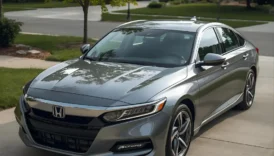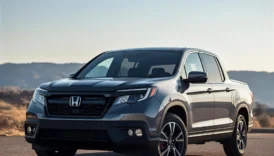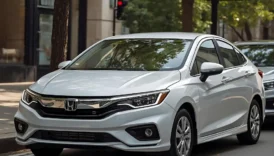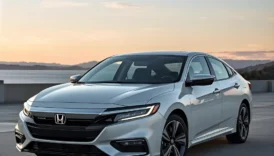2025 Honda Civic: Key Features & Highlights
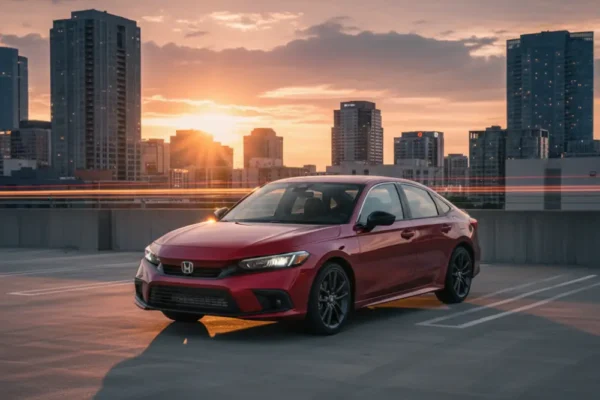
- 2025 Honda Civic: Key Features & Highlights
- What’s New in the 2025 Honda Civic?
- Key Updates for 2025
- Design Philosophy
- Why These Changes Matter
- Engine Options and Performance Overview
- Gasoline Engine Options
- Hybrid Powertrain
- Transmission and Drivetrain
- Real-World Performance
- Driving Experience and Handling Characteristics
- Steering Precision and Ride Quality
- Handling and Chassis Dynamics
- Urban Driving and Maneuverability
- Highway Comfort and Stability
- Overall Driving Feel
- Interior Comfort and Technology Features
- Cabin Design and Layout
- Seating Comfort and Space
- Cabin Storage and Practicality
- Digital Displays and Instrumentation
- Comfort and Ambiance
- Overall Interior Experience
- Safety Systems and Driver Assistance
- Structural Safety and Passive Protection
- Honda Sensing Suite – Standard Across All Trims
- Additional Driver-Assistance Features
- Real-World Safety Performance
- Overall Safety Impression
- Infotainment and Connectivity
- Central Touchscreen and User Interface
- Smartphone Integration and Connectivity Features
- Audio Systems
- Digital Integration and Customization
- Voice Control and Convenience
- Overall Infotainment Experience
- Fuel Efficiency and Real-World Economy
- 2.0-Liter Gasoline Engine Efficiency
- 1.5-Liter Turbocharged Engine Efficiency
- Hybrid Powertrain Efficiency
- Aerodynamics and Efficiency Enhancements
- Urban vs. Highway Economy
- Overall Efficiency Outlook
- Common Problems and Reliability Insights
- Infotainment Software Glitches
- Driver Assistance Sensor Sensitivity
- CVT and e-CVT Behavior
- Hybrid Battery and Electrical Considerations
- Build Quality and Interior Rattles
- Overall Reliability Outlook
- Maintenance Schedule and Ownership Practicalities
- Standard Maintenance Intervals
- Ownership Costs and Practical Benefits
- Practical Ownership Experience
- Long-Term Reliability and Resale
- Dimensions, Cargo Capacity, and Everyday Usability
- Exterior and Interior Dimensions
- Cargo Capacity and Flexibility
- Everyday Urban Usability
- Practical Features for Daily Life
- Overall Practicality
- Frequently Asked Questions About the 2025 Honda Civic
- What engine options are available for the 2025 Honda Civic?
- How fuel-efficient is the 2025 Honda Civic?
- Is the 2025 Honda Civic a reliable car?
- What are the most common problems with the 2025 Honda Civic?
- What safety features does the 2025 Honda Civic include?
- How practical is the 2025 Honda Civic for daily use?
- What is the recommended maintenance schedule for the 2025 Honda Civic?
The 2025 Honda Civic continues its legacy as one of the most well-rounded compact cars on the market, offering a blend of practicality, efficiency, modern technology, and engaging driving dynamics. With a refreshed design, improved infotainment systems, and efficient powertrains—including hybrid options in some trims—the new Civic appeals to a wide range of drivers, from urban commuters to enthusiasts seeking a balanced daily driver. In this comprehensive guide, we’ll explore the Civic’s engines, driving experience, interior comfort, safety features, real-world efficiency, common issues, and more.
What’s New in the 2025 Honda Civic?
The 2025 Honda Civic builds on the strengths of the previous generation with a series of key updates to design, technology, powertrain options, and safety, ensuring it remains one of the top contenders in the compact car segment. Honda has focused on refinement, efficiency, and user experience, making this model year a well-balanced evolution rather than a radical redesign.
Key Updates for 2025
- Refreshed Exterior Styling: The 2025 Civic receives subtle design tweaks, including a revised front grille, new LED lighting signatures, and updated wheel designs that enhance its modern, athletic stance.
- Improved Hybrid Powertrain Availability: Honda expands the hybrid system to more trims, offering better fuel economy and smoother performance for a wider range of buyers.
- Enhanced Infotainment System: All models now feature standard larger touchscreens, faster processing, and improved smartphone connectivity, bringing the Civic’s technology closer to premium rivals.
- Upgraded Safety Suite: The Honda Sensing suite gets updated radar and camera sensors for more accurate lane-keeping, adaptive cruise control, and collision mitigation.
- Interior Material Enhancements: Higher trims now offer upgraded upholstery, soft-touch panels, and new trim finishes that give the cabin a more upscale feel.
- Chassis and Suspension Refinements: Honda has fine-tuned the suspension and steering calibration, improving ride comfort while maintaining the Civic’s signature engaging dynamics.
Design Philosophy
The 2025 Civic retains its clean, low-profile silhouette and wide stance that give it a confident, planted look. Subtle tweaks, such as slimmer headlights and a sharper rear fascia, modernize the design without straying from the model’s core identity. It remains instantly recognizable but fresher and more sophisticated.
Why These Changes Matter
These updates strengthen the Civic’s position as a practical yet enjoyable compact car, appealing to a broad audience. With better hybrid integration, improved tech, and upgraded materials, the 2025 Civic continues to offer a compelling mix of efficiency, comfort, and driving enjoyment, ensuring it remains a benchmark in its class.
Engine Options and Performance Overview
The 2025 Honda Civic offers a well-balanced lineup of efficient and responsive engines, including traditional gasoline powertrains and a new-generation hybrid system. This diverse range ensures that whether you prioritize fuel economy, smooth everyday performance, or a bit more spirited driving, there’s a Civic configuration to suit your needs.
Gasoline Engine Options
- 2.0-Liter Naturally Aspirated Inline-4
- Power: 158 hp
- Torque: 138 lb-ft
- Transmission: Continuously Variable Transmission (CVT)
- Drivetrain: Front-wheel drive
- 0–60 mph: Around 8.5 seconds
- 1.5-Liter Turbocharged Inline-4
- Power: 180 hp
- Torque: 177 lb-ft
- Transmission: CVT
- Drivetrain: Front-wheel drive
- 0–60 mph: Around 7.4 seconds
Hybrid Powertrain
For 2025, Honda expands the availability of its two-motor hybrid system previously found only in select trims:
- Total System Output: 204 hp (combined)
- Torque: 247 lb-ft
- Transmission: E-CVT (electronic continuously variable transmission)
- Drivetrain: Front-wheel drive
- 0–60 mph: Around 7.0 seconds
The hybrid powertrain combines a 2.0-liter Atkinson-cycle engine with two electric motors, delivering smooth, quiet acceleration, excellent low-end torque, and significantly improved fuel economy. The E-CVT mimics gear changes to avoid the “rubber band” feeling typical of older CVTs, resulting in a more natural driving experience.
Transmission and Drivetrain
All 2025 Civics use front-wheel drive, with no AWD option offered. The CVT and e-CVT transmissions are tuned for efficiency and smoothness, with simulated gear steps on higher trims to enhance driver engagement. Paddle shifters are available on some models for manual-like control.
Real-World Performance
- The 2.0-liter engine is ideal for city driving and budget-conscious buyers.
- The 1.5-liter turbo provides a more refined and lively driving experience, especially on highways.
- The hybrid powertrain is the standout for its combination of performance and fuel savings, offering quick low-speed response and quiet cruising.
Overall, the 2025 Civic’s engine lineup offers something for everyone, from efficient commuting to more spirited everyday driving, all backed by Honda’s reputation for reliability.
Driving Experience and Handling Characteristics
The 2025 Honda Civic continues to deliver one of the most balanced and engaging driving experiences in the compact car segment. Honda’s engineers have refined the suspension, steering, and chassis tuning to improve comfort and stability while retaining the Civic’s trademark agility and driver-focused dynamics.
Steering Precision and Ride Quality
The Civic’s electric power steering remains one of the best in its class, offering precise response and excellent on-center feel. It’s light enough for easy city maneuvering but firms up progressively at higher speeds, giving the driver a confident sense of control.
For 2025, Honda has further tuned the suspension dampers and chassis bushings, resulting in a ride that’s both comfortable over rough surfaces and composed through corners. The Civic soaks up potholes and expansion joints without feeling floaty or disconnected, striking an impressive balance between compliance and sportiness.
- Standard suspension provides a smooth and stable ride for everyday commuting.
- Sport trims feature slightly firmer tuning, enhancing cornering stability without compromising daily comfort.
- Hybrid models benefit from chassis tweaks to compensate for battery weight, maintaining sharp handling characteristics.
Handling and Chassis Dynamics
Built on Honda’s enhanced global compact platform, the 2025 Civic has a low center of gravity and wide track, which contribute to its planted stance in corners. Body roll is minimal, and the suspension tuning inspires confidence even when driving enthusiastically.
The multi-link rear suspension on most trims improves stability and comfort over uneven roads compared to simpler torsion-beam setups found in some competitors. Combined with a rigid chassis structure, this gives the Civic a level of precision and refinement uncommon in its class.
Urban Driving and Maneuverability
In the city, the Civic excels at being easy to maneuver and predictably responsive:
- Tight turning radius makes parking and U-turns simple.
- Light, accurate steering boosts driver confidence in crowded environments.
- Excellent visibility, with thin A-pillars and well-placed mirrors, minimizes blind spots.
Highway Comfort and Stability
On the highway, the Civic feels solid and composed, benefiting from improved sound insulation and suspension tuning. The hybrid model, in particular, offers whisper-quiet cruising at moderate speeds. Adaptive cruise control and lane-keeping assist reduce fatigue on longer drives, while the car remains stable even at higher cruising speeds.
Overall Driving Feel
The 2025 Honda Civic delivers a mature, refined driving experience without losing its engaging character. It’s fun to drive when you want it to be, yet calm and comfortable when cruising—making it a standout choice for drivers who want both everyday practicality and dynamic handling in one package.
Interior Comfort and Technology Features
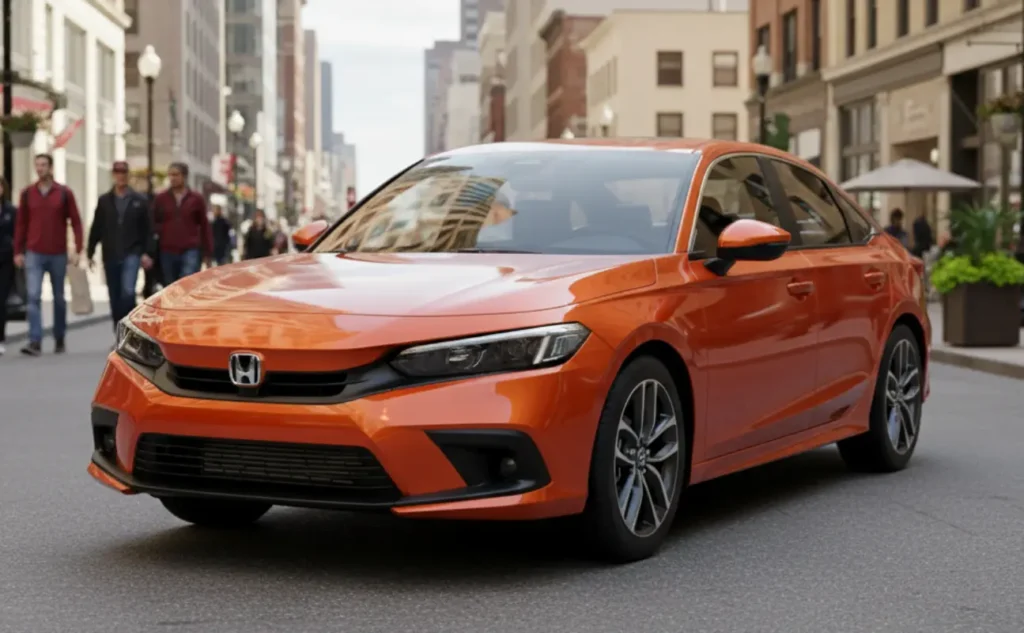
The 2025 Honda Civic raises the bar for interior quality and user experience in the compact segment. It blends clean, horizontal design lines, premium materials, and modern digital technology, creating a cabin that feels both functional and upscale. Honda has refined the interior to improve comfort, usability, and overall ambiance, making daily driving more enjoyable.
Cabin Design and Layout
The Civic’s interior continues with its minimalist, driver-focused layout, featuring a low cowl for improved outward visibility and a sleek dashboard with a distinctive metal honeycomb mesh that cleverly integrates the air vents. This design gives the cabin a clean, uncluttered look while maintaining intuitive access to all controls.
The center console is angled slightly toward the driver, and physical knobs are retained for climate controls—a thoughtful touch that improves usability compared to touchscreen-only systems.
Seating Comfort and Space
- Front seats are well-contoured with generous bolstering and support, making them comfortable for both short commutes and long trips. Higher trims offer power-adjustable, heated seats, and ventilated options may be available in select markets.
- Rear seat space remains one of the best in its class, with excellent legroom and headroom for adult passengers. The flat floor design improves middle-seat comfort, and wide-opening rear doors make ingress and egress easy.
- Upholstery materials have been upgraded for 2025, with soft-touch panels and new fabric or leather options on mid to upper trims, giving the interior a more premium feel.
Cabin Storage and Practicality
The Civic’s cabin is filled with clever storage solutions:
- A deep center console bin with sliding armrest
- Large door pockets for bottles and everyday items
- Covered cubby spaces near the shifter for phones and wallets
- Multiple USB-A and USB-C ports, plus available wireless charging on higher trims
These thoughtful touches make it easy to keep the cabin organized on daily drives.
Digital Displays and Instrumentation
- Digital Instrument Cluster: Higher trims feature a fully digital 10.2-inch instrument panel, offering sharp graphics and customizable layouts for navigation, driver-assistance info, and performance data. Lower trims retain a partially digital display that’s still clear and functional.
- Central Infotainment Screen: All trims now feature larger touchscreens—7 inches standard, with a 9-inch display on upper trims. The interface has been updated for faster response and cleaner menus, making it easy to access media, navigation, and vehicle settings.
Comfort and Ambiance
Improved sound insulation, soft-touch surfaces, and upgraded materials give the 2025 Civic a calm, premium feel at cruising speeds. Optional ambient interior lighting and dual-zone climate control enhance the sense of refinement, rivaling some entry-level luxury models.
Overall Interior Experience
The 2025 Honda Civic interior blends comfort, usability, and modern technology seamlessly. It’s thoughtfully designed for everyday practicality while providing the tactile quality and digital sophistication expected by today’s drivers—making it one of the most well-executed cabins in its class.
Safety Systems and Driver Assistance
The 2025 Honda Civic continues to set a strong standard for safety in the compact segment, featuring Honda’s latest Sensing suite, a rigid body structure, and a wide range of driver-assistance technologies. With upgraded sensors and improved calibration for 2025, the Civic delivers both active and passive protection that rivals many more expensive vehicles.
Structural Safety and Passive Protection
The Civic is built on Honda’s Advanced Compatibility Engineering (ACE) platform, which uses a combination of high-strength steel and strategically engineered crumple zones to absorb and redirect crash forces away from occupants. This strong foundation contributes to excellent crash test performance across global safety agencies.
Standard passive safety equipment includes:
- Front, side, curtain, and knee airbags
- Anti-lock Braking System (ABS)
- Electronic Brakeforce Distribution (EBD)
- Vehicle Stability Assist (VSA)
- Tire Pressure Monitoring System (TPMS)
- Front seatbelt pretensioners and load limiters
Honda Sensing Suite – Standard Across All Trims
For 2025, Honda Sensing is standard on every Civic, and its functionality has been improved with new camera and radar hardware. The updated system provides quicker responses and smoother operation in real-world driving. Core features include:
- Collision Mitigation Braking System (CMBS) – Detects potential frontal collisions and applies brakes automatically to reduce impact severity.
- Road Departure Mitigation (RDM) – Helps prevent unintentional lane departure by applying steering and braking inputs.
- Lane Keeping Assist System (LKAS) – Gently centers the vehicle in its lane on highways.
- Adaptive Cruise Control (ACC) with Low-Speed Follow – Maintains a safe following distance, even in stop-and-go traffic.
- Traffic Sign Recognition (TSR) – Displays detected speed limits and traffic signs on the digital cluster.
Additional Driver-Assistance Features
Higher trims or option packages offer even more technologies, such as:
- Blind Spot Information System (BSI) with Rear Cross-Traffic Monitor
- Front and Rear Parking Sensors
- Automatic High-Beam Headlights
- Driver Attention Monitor, which detects signs of fatigue or distraction and issues alerts.
- Low-Speed Braking Control, which automatically applies the brakes to prevent minor parking impacts.
Real-World Safety Performance
The Civic has historically earned top ratings in IIHS and NHTSA crash tests, and the 2025 model is expected to continue this trend thanks to its upgraded structure and improved sensor technology. In daily driving, the systems work smoothly and predictably, supporting rather than overwhelming the driver.
Overall Safety Impression
With a robust structure, a comprehensive active safety suite, and refined assistance features, the 2025 Honda Civic offers excellent all-around protection. Whether navigating busy urban environments or cruising on the highway, it provides a reassuring layer of safety and driver confidence.
Infotainment and Connectivity
The 2025 Honda Civic receives a notable upgrade to its infotainment and connectivity systems, bringing them closer in quality and functionality to what’s offered in premium vehicles. With larger screens, faster processors, and enhanced smartphone integration, the Civic ensures a modern, intuitive, and connected driving experience.
Central Touchscreen and User Interface
All 2025 Civic trims now come standard with a larger infotainment display:
- 7-inch touchscreen on base trims
- 9-inch touchscreen on mid and upper trims
The new system features crisper graphics, faster response times, and a cleaner, tile-based layout that makes navigating menus simple and distraction-free. The screen is positioned high on the dashboard to minimize eye movement, improving safety and ergonomics.
Physical volume and tuning knobs remain, making it easy to control audio without fumbling through touch menus—an appreciated detail often missing in competitors.
Smartphone Integration and Connectivity Features
The 2025 Civic includes standard Apple CarPlay and Android Auto, with wireless connectivity on the 9-inch system. This enables drivers to use their preferred navigation apps, stream music, send messages, and make calls seamlessly.
Additional connectivity features include:
- Multiple USB-A and USB-C ports for both front and rear passengers
- Wireless charging pad available on higher trims
- Bluetooth audio streaming with quick pairing
- Over-the-air (OTA) software updates, ensuring the system remains up to date without visiting the dealership.
Audio Systems
- Standard audio on lower trims provides clear, balanced sound for everyday use.
- Mid-level trims upgrade to an 8-speaker system, delivering improved clarity.
- The top Touring trim offers a 12-speaker Bose premium audio system, including a subwoofer, for a rich, immersive listening experience that rivals many luxury cars.
Digital Integration and Customization
The infotainment system integrates smoothly with the digital instrument cluster, allowing drivers to display navigation prompts, media info, and smartphone notifications directly in their line of sight. System customization options allow users to reorder app tiles, adjust themes, and set personal driver profiles.
Voice Control and Convenience
The improved voice recognition system allows drivers to control key functions like climate, navigation, and media hands-free using natural language commands. This reduces the need to interact physically with the screen, minimizing distraction during driving.
Overall Infotainment Experience
With its fast, intuitive interface, wireless connectivity, and optional premium audio, the 2025 Honda Civic’s infotainment system is one of the strongest in its class. It combines Honda’s traditional ease of use with modern digital sophistication, enhancing both everyday convenience and long-distance comfort.
Fuel Efficiency and Real-World Economy
The 2025 Honda Civic continues to be one of the most fuel-efficient vehicles in the compact segment, offering excellent economy across its 2.0-liter, 1.5-liter turbo, and hybrid powertrains. Whether used for city commuting or long highway drives, the Civic’s aerodynamic design, refined engines, and intelligent transmission tuning help deliver outstanding real-world efficiency.
2.0-Liter Gasoline Engine Efficiency
The naturally aspirated 2.0-liter engine focuses on reliability and fuel savings.
- City / Highway / Combined: Approx. 31 / 40 / 35 mpg US (7.6 / 5.9 / 6.7 L/100 km)
- Real-world performance: Consistently matches EPA ratings with careful driving.
This engine is ideal for drivers who want low maintenance costs and solid efficiency without the complexity of turbocharging or hybrid systems.
1.5-Liter Turbocharged Engine Efficiency
The 1.5-liter turbo offers more power without significantly sacrificing economy:
- City / Highway / Combined: Approx. 33 / 42 / 36 mpg US (7.1 / 5.6 / 6.5 L/100 km)
- Real-world performance: Particularly efficient on highways thanks to low RPM cruising and smart CVT tuning.
Turbo trims are a sweet spot for drivers who want extra performance but still value fuel savings.
Hybrid Powertrain Efficiency
The hybrid powertrain is the standout for 2025, offering both strong acceleration and exceptional economy:
- City / Highway / Combined: Around 45 / 50 / 48 mpg US (5.2 / 4.7 / 4.9 L/100 km) depending on driving style and trim.
- Real-world performance: The electric motors handle low-speed driving and assist the engine at higher speeds, making it especially efficient in stop-and-go traffic.
The E-CVT transmission allows seamless transitions between electric and gasoline power, while regenerative braking helps recapture energy during deceleration.
Aerodynamics and Efficiency Enhancements
The 2025 Civic’s sleek exterior design, with a low hood and smooth roofline, helps reduce drag and improve highway economy. Other contributing factors include:
- Smart engine stop-start system for idle reduction
- Refined CVT programming that keeps the engine in its most efficient range
- Lightweight construction, minimizing energy expenditure without sacrificing safety
Urban vs. Highway Economy
- In city driving, the hybrid model clearly leads, taking advantage of frequent coasting and regenerative braking.
- On highways, both the 1.5 turbo and hybrid deliver exceptional mileage, often exceeding official ratings when driven smoothly.
Overall Efficiency Outlook
With three well-optimized powertrains, the 2025 Honda Civic delivers class-leading fuel efficiency across the board. Drivers can choose the version that best fits their lifestyle—whether that’s low-cost commuting, balanced performance, or maximum eco-friendliness with the hybrid.
Common Problems and Reliability Insights

The 2025 Honda Civic is built on a proven platform and benefits from Honda’s longstanding reputation for durability and reliability. While major issues are rare, especially in the first production year of this lightly updated model, there are a few minor concerns and considerations potential owners should be aware of. Most involve software or maintenance-related aspects rather than mechanical failures.
Infotainment Software Glitches
Some early testers and owners have noted occasional software bugs with the updated infotainment system, including:
- Temporary Bluetooth connection drops when switching between devices
- Minor touchscreen lag on the 7-inch base system during startup
- Voice assistant occasionally misinterpreting commands in noisy environments
These issues are usually resolved with over-the-air updates, which Honda provides regularly to improve system stability and functionality.
Driver Assistance Sensor Sensitivity
Because the 2025 Civic uses upgraded radar and camera sensors for Honda Sensing, some drivers have experienced false alerts, especially in poorly marked lanes or heavy rain. For example:
- Lane Keeping Assist may momentarily detect phantom lane lines.
- Forward Collision Warning can be triggered by large roadside objects.
These incidents are generally infrequent and can often be reduced by keeping sensors clean and properly calibrated during scheduled maintenance.
CVT and e-CVT Behavior
While Honda’s CVTs are known for their smoothness and reliability, some owners may notice:
- Slight hesitation or rubber-band feel during hard acceleration in base CVT models.
- Low-speed shudder if transmission fluid changes are neglected.
- E-CVT systems in hybrids are generally trouble-free but rely on proper software updates for optimal performance.
Regular fluid changes at the recommended intervals help maintain the transmission’s characteristic smoothness and prevent long-term wear.
Hybrid Battery and Electrical Considerations
The hybrid model’s lithium-ion battery pack is designed for the vehicle’s lifetime, but it performs best with regular use. Extended periods of inactivity can reduce efficiency temporarily. Honda covers hybrid components with long warranties, and historical data from previous models shows excellent reliability for these systems.
Build Quality and Interior Rattles
As with many compact cars, a few owners report minor rattles or squeaks developing in the cabin over time, particularly around the dashboard or door panels. These are typically small fit-and-finish issues and can be easily addressed during regular servicing or under warranty.
Overall Reliability Outlook
The 2025 Honda Civic is expected to deliver excellent long-term reliability, thanks to its proven powertrains, refined electronics, and Honda’s consistent build quality. Most issues are minor and software-related, easily managed through regular maintenance and updates. Historically, Civics are known to exceed 200,000–300,000 km (124,000–186,000 miles) with minimal major repairs—making this model a dependable choice for long-term ownership.
Maintenance Schedule and Ownership Practicalities
The 2025 Honda Civic is designed for low running costs and long-term dependability, supported by a clear and predictable maintenance schedule. Honda’s proven engineering and widespread service network make the Civic one of the most cost-effective compact cars to own over time.
Standard Maintenance Intervals
Honda uses a Maintenance Minder system, which monitors driving conditions and alerts the driver when specific services are required. Typical service intervals include:
- Engine oil and filter: Every 12 months or 10,000–12,000 miles (16,000–19,000 km), depending on driving style.
- Air filter: Every 30,000–45,000 km (18,000–28,000 miles), more frequently in dusty areas.
- Cabin air filter: Every 20,000–25,000 km (12,000–15,000 miles).
- CVT transmission fluid: Approximately every 60,000–80,000 km (37,000–50,000 miles).
- Hybrid e-CVT system fluid: Similar intervals to CVT, checked during regular service.
- Spark plugs (gasoline engines): Around 100,000 km (62,000 miles).
- Brake fluid: Every 3 years.
- Coolant: Every 5 years or as specified.
- Tire rotation and balancing: Every 10,000–12,000 km (6,000–7,500 miles).
The Maintenance Minder displays service codes on the instrument panel, making it easy for owners to know exactly what’s due and when.
Ownership Costs and Practical Benefits
Honda vehicles, including the Civic, are known for their low cost of ownership.
- Routine services are generally affordable compared to European competitors.
- Spare parts are widely available and reasonably priced.
- Labor times for most services are short, keeping workshop bills low.
- Hybrid system maintenance is minimal, with no special servicing needed outside fluid checks and software updates.
Extended warranty and prepaid service plans are available in many markets, allowing owners to lock in maintenance costs and ensure all services are performed at authorized Honda centers.
Practical Ownership Experience
Honda has made ownership even easier with connected services and digital reminders:
- Through the HondaLink app, owners can schedule services, receive notifications, and view digital service history.
- The Civic’s reliable powertrains and simple mechanical layout make it a favorite among independent mechanics, which can further reduce costs once out of warranty.
- The hybrid model requires little extra attention beyond routine servicing, thanks to Honda’s robust hybrid design.
Long-Term Reliability and Resale
Regular maintenance ensures the Civic’s engines, transmission, and hybrid systems remain smooth and efficient well beyond 100,000 miles. Civics have historically held strong resale values, especially hybrid and turbocharged trims, because of their reputation for durability and low upkeep.
Dimensions, Cargo Capacity, and Everyday Usability
The 2025 Honda Civic combines sleek exterior styling with impressively efficient interior packaging, making it both easy to maneuver in urban settings and practical for everyday use. Whether you choose the sedan or hatchback body style, the Civic provides generous space for passengers and cargo without feeling bulky on the road.
Exterior and Interior Dimensions
For 2025, the Civic retains its well-proportioned footprint that balances stability with agility:
- Length (Sedan): 4,675 mm (184.1 in)
- Width: 1,801 mm (70.9 in)
- Height: 1,415 mm (55.7 in)
- Wheelbase: 2,735 mm (107.7 in)
These dimensions give the Civic a planted stance on the road while maximizing interior room. Inside, the cabin provides:
- Front headroom: 998 mm (39.3 in)
- Front legroom: 1,074 mm (42.3 in)
- Rear headroom: 942 mm (37.1 in)
- Rear legroom: 950 mm (37.4 in)
This interior space is among the best in the compact segment, offering ample room for both front and rear passengers.
Cargo Capacity and Flexibility
- Sedan: 419 liters (14.8 cu ft) of trunk space
- Hatchback: 693 liters (24.5 cu ft) with rear seats up; expands further with seats folded
The 60/40 split-folding rear seats make it easy to accommodate larger or longer items, while the wide trunk opening and low liftover height simplify loading heavy cargo. Hatchback models offer exceptional versatility, making the Civic a strong alternative to small crossovers.
Everyday Urban Usability
The Civic’s compact footprint and well-calibrated steering make it effortless to maneuver in tight spaces:
- Tight turning radius improves parking and urban navigation.
- Large mirrors and thin A-pillars enhance visibility, minimizing blind spots.
- Parking sensors and available multi-angle rearview camera support confident parking in crowded city environments.
Practical Features for Daily Life
Additional thoughtful touches that improve usability include:
- Multiple interior storage compartments for personal items and small electronics
- Wide-opening doors that simplify entry and exit for passengers of all ages
- Comfortable seating position and excellent sightlines for the driver
- Refined cabin insulation that keeps noise levels low during commutes
Overall Practicality
The 2025 Honda Civic offers one of the best blends of space, maneuverability, and everyday functionality in its class. Its spacious cabin, flexible cargo area, and easy-to-drive nature make it equally suited to urban commutes, family use, or weekend road trips—all while maintaining the Civic’s signature sporty, modern feel.
Frequently Asked Questions About the 2025 Honda Civic
What engine options are available for the 2025 Honda Civic?
The 2025 Honda Civic offers three powertrain options: a 2.0-liter naturally aspirated engine for efficiency-focused buyers, a 1.5-liter turbocharged engine for more spirited performance, and a hybrid system combining a 2.0-liter engine with two electric motors for the best balance of power and fuel economy. All variants use front-wheel drive and either a CVT or e-CVT transmission. This versatile lineup ensures there’s a Civic for every type of driver.
How fuel-efficient is the 2025 Honda Civic?
The 2025 Civic delivers class-leading efficiency across all powertrains. The 2.0-liter engine averages 31–40 mpg US, the 1.5-liter turbo achieves up to 42 mpg US on highways, and the hybrid excels with up to 50 mpg US combined, especially in urban environments. Aerodynamic design, smart transmission tuning, and lightweight construction help the Civic deliver real-world consumption that closely matches EPA estimates, making it one of the most economical choices in its class.
Is the 2025 Honda Civic a reliable car?
Yes. The Civic has a longstanding reputation for durability, and the 2025 model continues this legacy. Its powertrains are proven, and most reported issues are minor and software-related—such as occasional infotainment glitches or sensor recalibrations. Regular maintenance is straightforward and affordable, and many Civics exceed 200,000–300,000 km (124,000–186,000 miles) with minimal major repairs, making it one of the most dependable compact cars available.
What are the most common problems with the 2025 Honda Civic?
Early feedback points to infotainment software bugs, like occasional Bluetooth disconnections, and false alerts from advanced safety sensors in challenging conditions. CVT-equipped models may show slight hesitation if transmission fluid changes are neglected, while hybrid versions rely on regular use to keep the battery in top shape. None of these are widespread or severe, and most are addressed through routine updates or servicing.
What safety features does the 2025 Honda Civic include?
Every 2025 Civic comes with Honda Sensing as standard, offering adaptive cruise control, collision mitigation braking, lane keeping assist, road departure mitigation, and traffic sign recognition. Higher trims add blind spot monitoring, rear cross-traffic alert, and parking sensors. Combined with the rigid ACE body structure and multiple airbags, these systems provide excellent all-around safety, both in crash protection and accident prevention.
How practical is the 2025 Honda Civic for daily use?
The Civic excels in everyday practicality. It offers a spacious interior, generous cargo capacity (especially in hatchback form), and excellent maneuverability in urban settings. Visibility is superb, and thoughtful features like wide-opening doors, ample interior storage, and user-friendly tech make daily driving effortless. Whether for city commuting or road trips, the Civic is built to handle real-world tasks with comfort and ease.
What is the recommended maintenance schedule for the 2025 Honda Civic?
Honda uses a Maintenance Minder system, which typically schedules oil changes every 10,000–12,000 miles (16,000–19,000 km) and CVT fluid service every 60,000–80,000 km. Cabin filters, spark plugs, and brake fluid follow longer intervals. Hybrid models require similar servicing with additional checks on the e-CVT system. The schedule is simple, affordable, and ensures long-term reliability when followed consistently.

